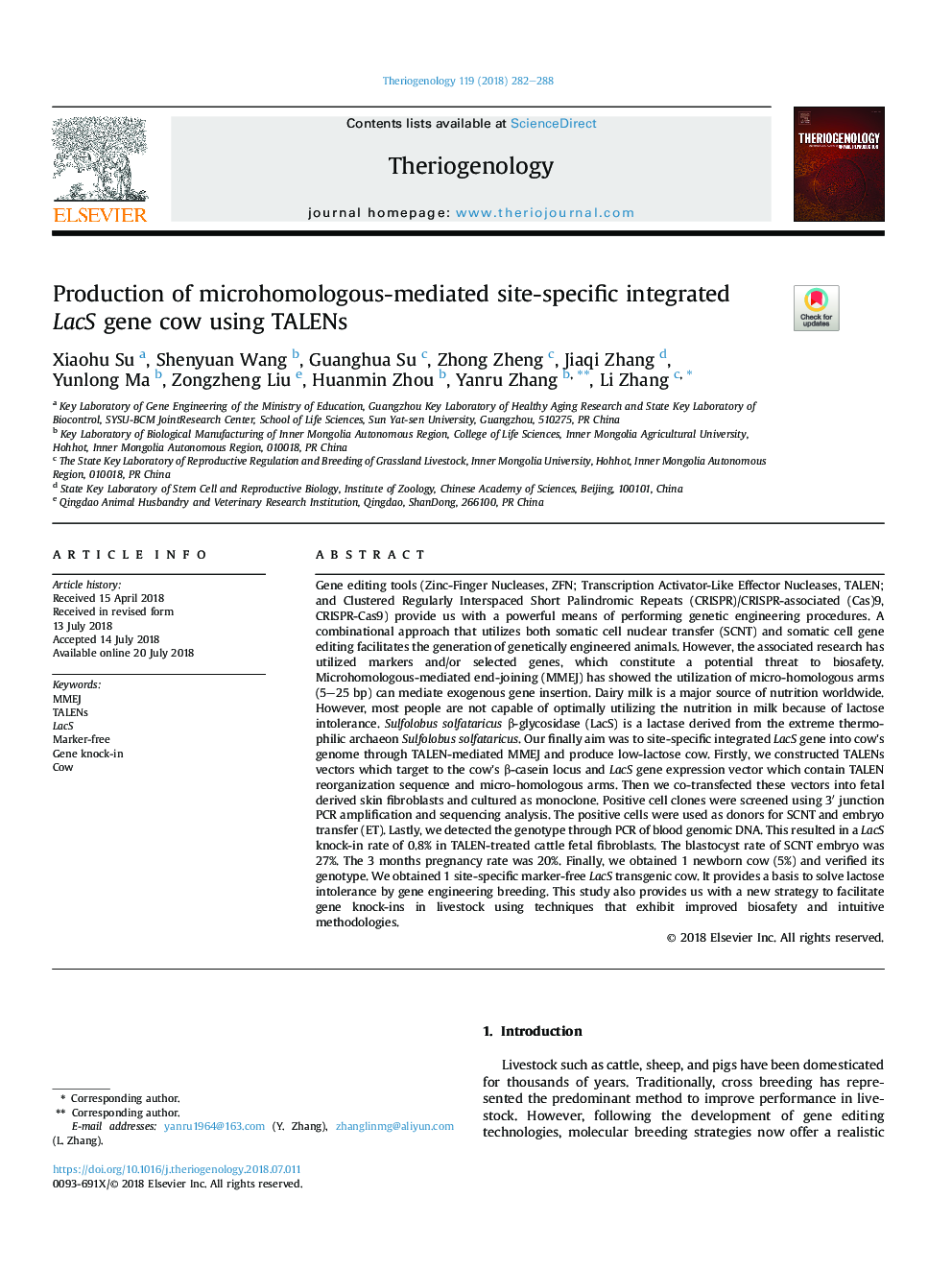| کد مقاله | کد نشریه | سال انتشار | مقاله انگلیسی | نسخه تمام متن |
|---|---|---|---|---|
| 8426455 | 1546050 | 2018 | 7 صفحه PDF | دانلود رایگان |
عنوان انگلیسی مقاله ISI
Production of microhomologous-mediated site-specific integrated LacS gene cow using TALENs
دانلود مقاله + سفارش ترجمه
دانلود مقاله ISI انگلیسی
رایگان برای ایرانیان
کلمات کلیدی
موضوعات مرتبط
علوم زیستی و بیوفناوری
علوم کشاورزی و بیولوژیک
علوم دامی و جانورشناسی
پیش نمایش صفحه اول مقاله

چکیده انگلیسی
Gene editing tools (Zinc-Finger Nucleases, ZFN; Transcription Activator-Like Effector Nucleases, TALEN; and Clustered Regularly Interspaced Short Palindromic Repeats (CRISPR)/CRISPR-associated (Cas)9, CRISPR-Cas9) provide us with a powerful means of performing genetic engineering procedures. A combinational approach that utilizes both somatic cell nuclear transfer (SCNT) and somatic cell gene editing facilitates the generation of genetically engineered animals. However, the associated research has utilized markers and/or selected genes, which constitute a potential threat to biosafety. Microhomologous-mediated end-joining (MMEJ) has showed the utilization of micro-homologous arms (5-25 bp) can mediate exogenous gene insertion. Dairy milk is a major source of nutrition worldwide. However, most people are not capable of optimally utilizing the nutrition in milk because of lactose intolerance. Sulfolobus solfataricus β-glycosidase (LacS) is a lactase derived from the extreme thermophilic archaeon Sulfolobus solfataricus. Our finally aim was to site-specific integrated LacS gene into cow's genome through TALEN-mediated MMEJ and produce low-lactose cow. Firstly, we constructed TALENs vectors which target to the cow's β-casein locus and LacS gene expression vector which contain TALEN reorganization sequence and micro-homologous arms. Then we co-transfected these vectors into fetal derived skin fibroblasts and cultured as monoclone. Positive cell clones were screened using 3Ⲡjunction PCR amplification and sequencing analysis. The positive cells were used as donors for SCNT and embryo transfer (ET). Lastly, we detected the genotype through PCR of blood genomic DNA. This resulted in a LacS knock-in rate of 0.8% in TALEN-treated cattle fetal fibroblasts. The blastocyst rate of SCNT embryo was 27%. The 3 months pregnancy rate was 20%. Finally, we obtained 1 newborn cow (5%) and verified its genotype. We obtained 1 site-specific marker-free LacS transgenic cow. It provides a basis to solve lactose intolerance by gene engineering breeding. This study also provides us with a new strategy to facilitate gene knock-ins in livestock using techniques that exhibit improved biosafety and intuitive methodologies.
ناشر
Database: Elsevier - ScienceDirect (ساینس دایرکت)
Journal: Theriogenology - Volume 119, 1 October 2018, Pages 282-288
Journal: Theriogenology - Volume 119, 1 October 2018, Pages 282-288
نویسندگان
Xiaohu Su, Shenyuan Wang, Guanghua Su, Zhong Zheng, Jiaqi Zhang, Yunlong Ma, Zongzheng Liu, Huanmin Zhou, Yanru Zhang, Li Zhang,